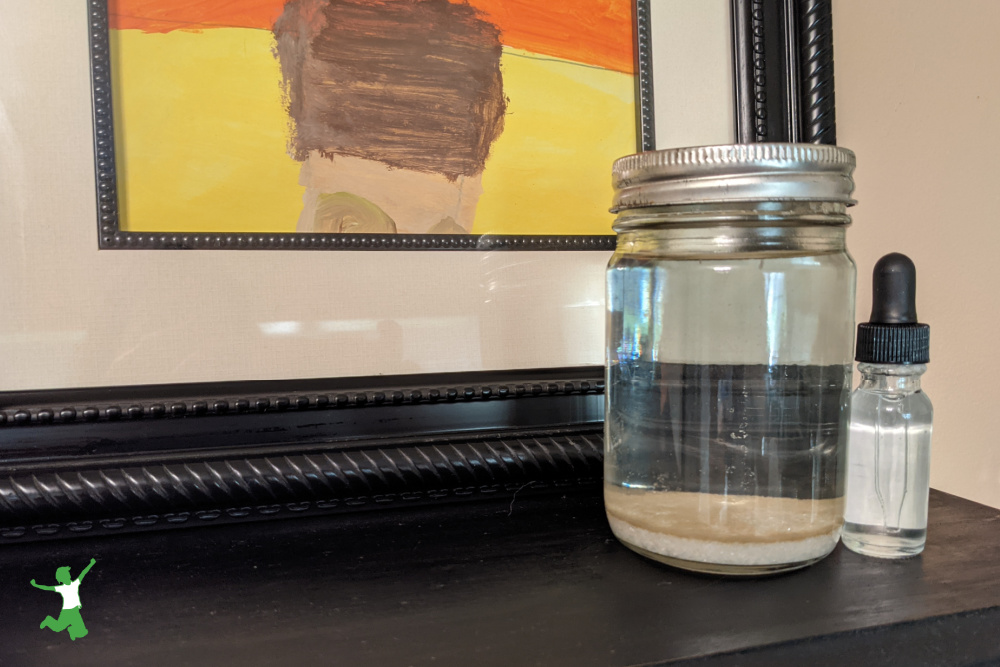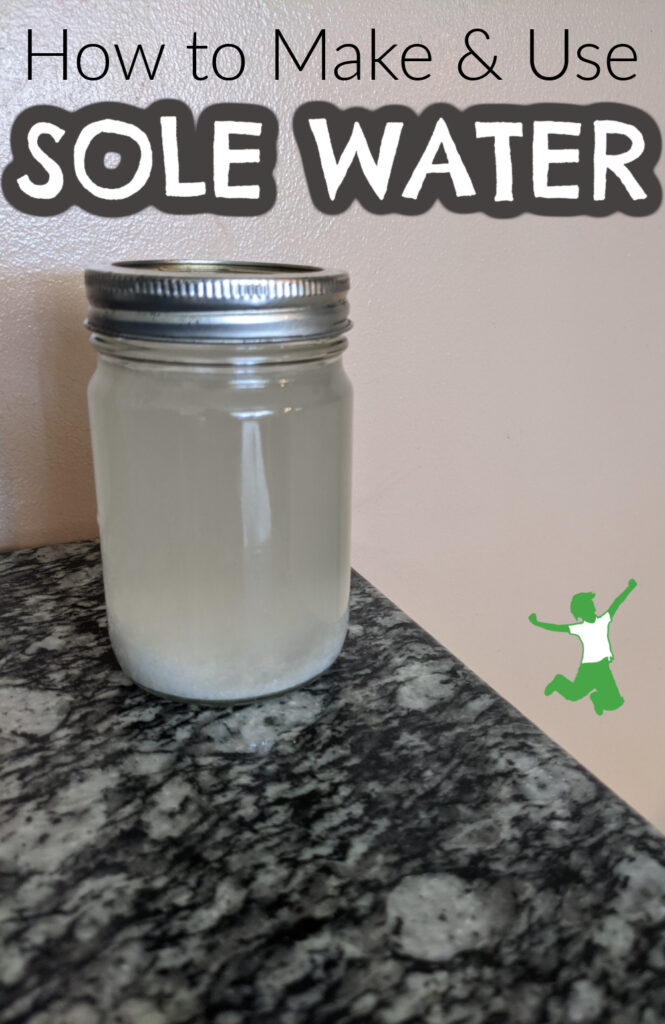How to make and use solé water, a super saturated salt solution that is a safe, easily absorbed colloidal supplement to ensure your body is getting sufficient ionic minerals for optimal function.

My post on the dangers of low salt diets (and why you should RUN if a doctor ever suggests one) resulted in a number of you reaching out about how to know whether you are getting sufficient good salt every day for optimal function.
As a result, I thought I would share my method for making solé (pronounced Sol-ay) water, a highly saturated solution that you make with filtered water and a mineral-rich raw sea salt.
You perhaps already are familiar with super saturated potassium iodide (SSKI) which is great for loosening congestion and as an expectorant. It’s a country doctor remedy my Dad used for decades in his practice.
Well, solé is simply a different natural remedy made from a mineral solution in water. It is used in droplet form in a similar fashion.
And, while many sources use pink Himalayan salt to make it, I recommend that you don’t as it’s not the best one to use. More on this below…
Solé Water Benefits
The benefits of solé solution are enormous in my personal experience including:
- Increased energy
- Better sleep
- More endurance when exercising
- Improved mental clarity and focus
- Greatly reduced sensitivity to heat (a big one for me in the summer!)
- Reduction/elimination of painful muscle cramping issues
There are many other benefits as well. (1)
I just list the ones above, as those are the ones I’ve personally noticed.
What Type of Sea Salt?
While most sources suggest making solé with Himalayan pink sea salt, I prefer to make it with this type of coarse gray salt which is tested for purity and is higher in minerals than any other. It is also tested free of microplastics.
Most people do not realize that Himalayan pink salt doesn’t even come from the Himalayas!
It is mined in Pakistan from many different mines involving a great variation in mineral composition (85-99% sodium chloride).
Thus, if you use pink Himalaya sea salt, you really have no idea what you are getting. (2)
By comparison, this sea salt from the Sea of Cortez in North America is consistently measured at 72% sodium (NaCl). (2)
Even Celtic sea salt is shockingly high by comparison at 88.5% sodium chloride. (2)
Redmond Real Salt is 98% sodium chloride, only 1% less than white refined table salt. (2)
Why is Lower Sodium Content A Good Thing?
Having a lower sodium content means there are MORE minerals. This includes over 90 minerals and trace elements for raw salt from the Sea of Cortez.
This is important not because sodium is “bad”. Again, less sodium in a sea salt simply means MORE minerals and trace elements.
Nutritional deficiency in some of these critical trace minerals that people simply do not get…EVER…even on a whole food diet can contribute to issues with lack of energy and propensity for disease.
While the major minerals such as magnesium, potassium, calcium, etc are a big focus for supplement companies, it’s the trace minerals that can make a huge impact once you get them into your diet.
And, a colloidal solution of mineral-rich ions from sea salt is not only highly absorbable but also the most cost-effective manner for accomplishing this!
How Solé Solution is Made
When purified water and raw mineralized sea salt come into contact, a new geometric structure is formed via a gentle chemical reaction.
This is what solé is by definition.
Negative poles in water molecules attract positive mineralized salt ions.
In addition, negative mineralized salt ions attach to positive polarized particles of water molecules.
Once this chemical reaction occurs, solé becomes molecularly different from its original components of plain water and sea salt.
The major minerals and trace elements, including magnesium, calcium, boron, selenium and sulfur, separate into ions in the water, releasing stored energy to form new molecular bonds with a higher energy level.
When you ingest small amounts of solé, these ions are in colloidal form and easily absorbed with little to no effort from the body.
An interesting factoid is that the amniotic fluid which keeps babies safe in their mother’s womb is solé too!
Making Solé at Home
The best way to enjoy the benefits of an authentic solé solution is to make it yourself.
All that is required is a small glass jar with a lid, a few tablespoons of mineral-rich sea salt (this one is the best by far), and filtered water.
Easy Steps
Here are the simple steps!
- Fill a small half-pint glass jar one-quarter full with mineral-rich sea salt.
- Add filtered water to just below the rim of the jar.
- Close the lid tightly and turn the jar several times to thoroughly mix the salt with the water.
- Place jar on the counter for 24 hours.
- After one day has passed, if there is still some salt in the bottom of the jar, the water portion is now solé! You can use it as is or transfer some of the water into a smaller bottle with an eyedropper to keep by your bedside (for use first thing in the morning and before bed).
- If all the salt is gone, add another tablespoon or two and repeat steps #3 and #4 until a small amount of salt remains at the bottom of the jar.
That’s all there is to it!
How to Use
There are two ways to use solé on a daily basis.
Under the Tongue
First, you can use an eyedropper and drip 5-10 drops under the tongue first thing in the morning and just before bed.
This is the “homeopathic-style” method I use as I love the mildly salty taste and can leave the drops in the mouth for a minute or so before swallowing.
This allows maximum absorption of the ions straight into the bloodstream from the very thin gum tissues.
Teaspoon in a Glass of Water
The second way to use solé is to stir one teaspoon into a glass of water and drink it immediately. This is the method most people use.
Whichever method suits you best, use that one!
The important thing is to do this daily for best results.
How Much Sodium in Solé?
One teaspoon of solé made with sea salt from the Sea of Cortez (my strong recommendation) contains 478 mg of sodium.
This is roughly 20% of the USDA’s recommended daily allowance of 2,300 mg (1 tsp per day).
Note that the USDA RDA for sodium is way too low. This level is actually harmful to the vast majority of people.
According to the Weston Price Foundation, humans need at least one and one-half teaspoons of salt per day (roughly 3500 mg), and some do better on double that amount. (3)
Thus, solé is not only a great way to ensure you are getting plenty of ionic trace minerals, it is a good way to make sure you are taking in enough sodium for optimal health too.

(1) Sole: The Ultimate Guide
(2) Which Salt Has the Most Minerals?
(3) Targeting Salt








I purchased some of this salt last year and used it up. when I just looked at reordering, it has almost doubled in price, from $30 to $55. Any chance it will go down in price?
In these inflationary times… probably not unfortunately.
Do you re-use the salt at the bottom of the jar or do you toss it?
I use it for salting bone broth, but I don’t reuse to make more sole.
Hi Sarah, I’m a little confused about the drops vs teaspoon. I measured out 10 drops and it’s about 1/8 tsp, making the teaspoon quite a bit more.. So the teaspoon seems like too much or is it ok because when the sole is added to water it’s diluted? I’d love to try this, but would you please clarify the difference in the measurements. As always, love your newsletter.
The tsp in a glass of water is what most sites that recommend sole say. As with many things, there is variation in suggestions for how to use sole within the health community. I tell you about both approaches so use what you think is best. I use the drops under the tongue morning and night and that has worked great for me, which is why I am suggesting that. I feel that absorption may be better as the trace mineral ions can go DIRECTLY into the blood via the thin gum tissues. People with absorption issues in the gut may not experience the same benefits perhaps that is why more is recommended when you take via water? That is my sense of the differences currently without research comparing the two methods for results.
In Mexico we add Lime to the natural salt and water drink…really good that way.
Great electrolyte!!
Hi Sarah quick question, can you drink one teaspoon of solé in water twice daily the same as you mentioned taking the sublingual drops twice a day? Thank you kindly
Let me suggest to measure out 10 drops to see if it is 1 teaspoon … if it is, then you can have 1 teaspoon twice a day in water.
You don’t want to exceed 20 drops in a 24 hour period.
Thank you kindly Sarah! 1 teaspoon is much much more than 10 drops! I took 1 teaspoon twice daily and didn’t feel right as I felt very lightheaded! I will take 10 drops twice daily instead thank you kindly again!
I have 2 stents plus high blood pressure so have been on a low salt diet, but this sounds good ,so will try the sole
This sounds great, I’ve been looking to replace powerade and make its equivalent.
I play hockey, it’s a very demanding sport and always results in being drenched, you can even see the line of salt that escapes my body along the Forehead!
Do you have any recommendations for this? I’ve tried a fee mixes, I clouding coconut water but nothing seems to work as well as Powerade. But would like to avoid all the food colouringand other bad stuff.
Thank you!
I would suggest this electrolyte drink. I wrote this recipe years ago, so I would suggest replacing the sea salt portion with 10 drops of sole for extra potency. https://www.thehealthyhomeeconomist.com/homemade-electrolyte-replacement/
Hi I was wondering if you have any other recommendations of salts to use? The one you have linked is not available. Have you heard of Colima salt, and is that a good one to use? Thanks so much for your powerful information!!
Hi Haley, I haven’t come across Colima before. You will need to call the company and research it yourself to see if it is suitable. I do not have another brand to suggest at this time unfortunately.
Thank you for the response! Amazon currently lists the recommendation as “out of stock.”
They recommend Happy Belly (I think), do you have another brand recommendation?
They do have it in a 1# bag. I just ordered it. The $ per pound is higher but wanted my husband and I to get started. 5# seemed like a lot also!
Yes, it is more cost effective to get the 5#. You use it up … I have 3 – 5 lb bags in my pantry. I use it for cooking, not just sole. Lower sodium translates to better flavor in food too from all the minerals.
Hi Sarah, thank you for the information. Do you know of Selina Naturally Pink Salt. It is my understanding that it has an even lower sodium content.
That is not my understanding … if you buy pink salt, you really don’t know what you’re getting. Pink salt is between 85-98% sodium.